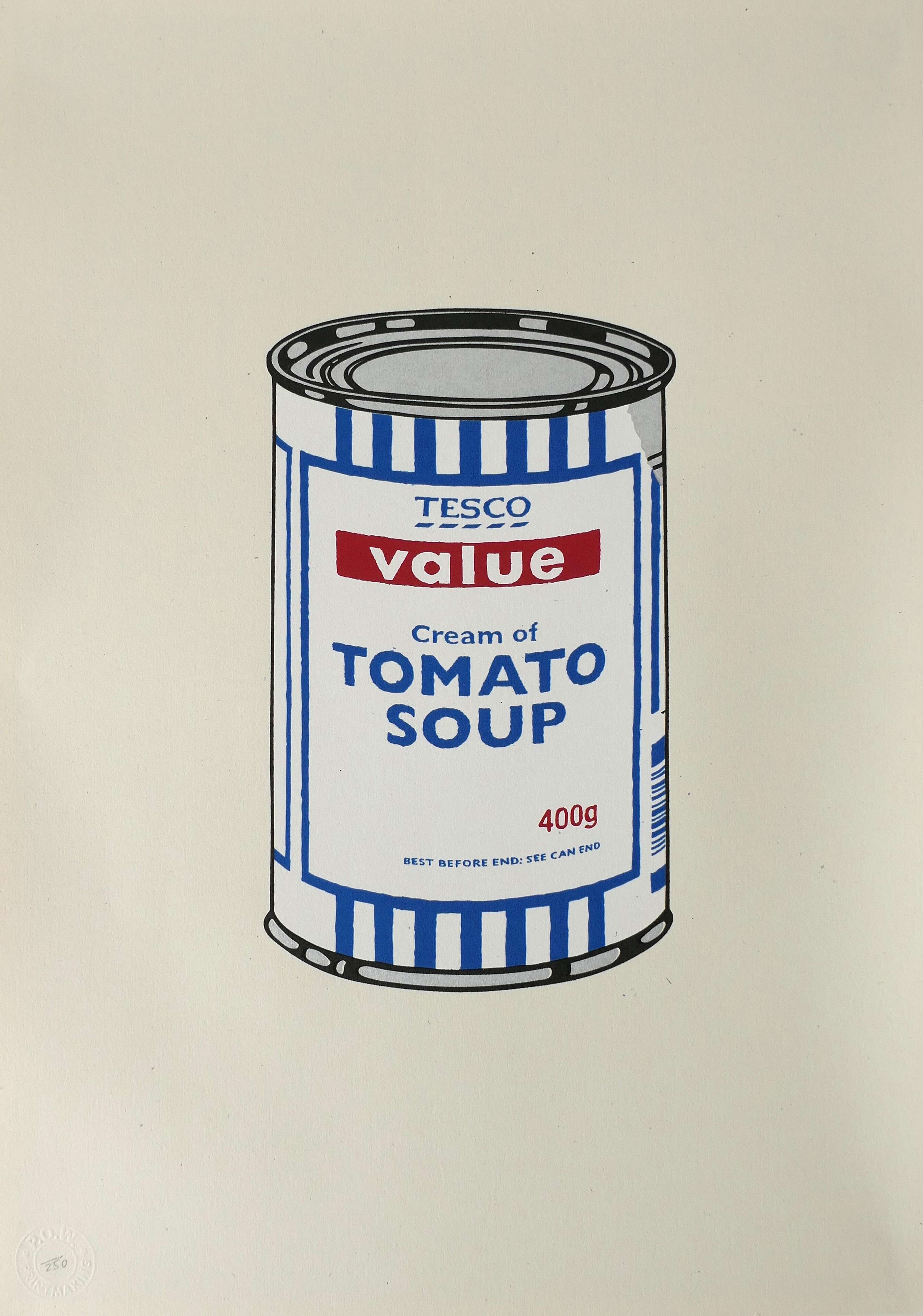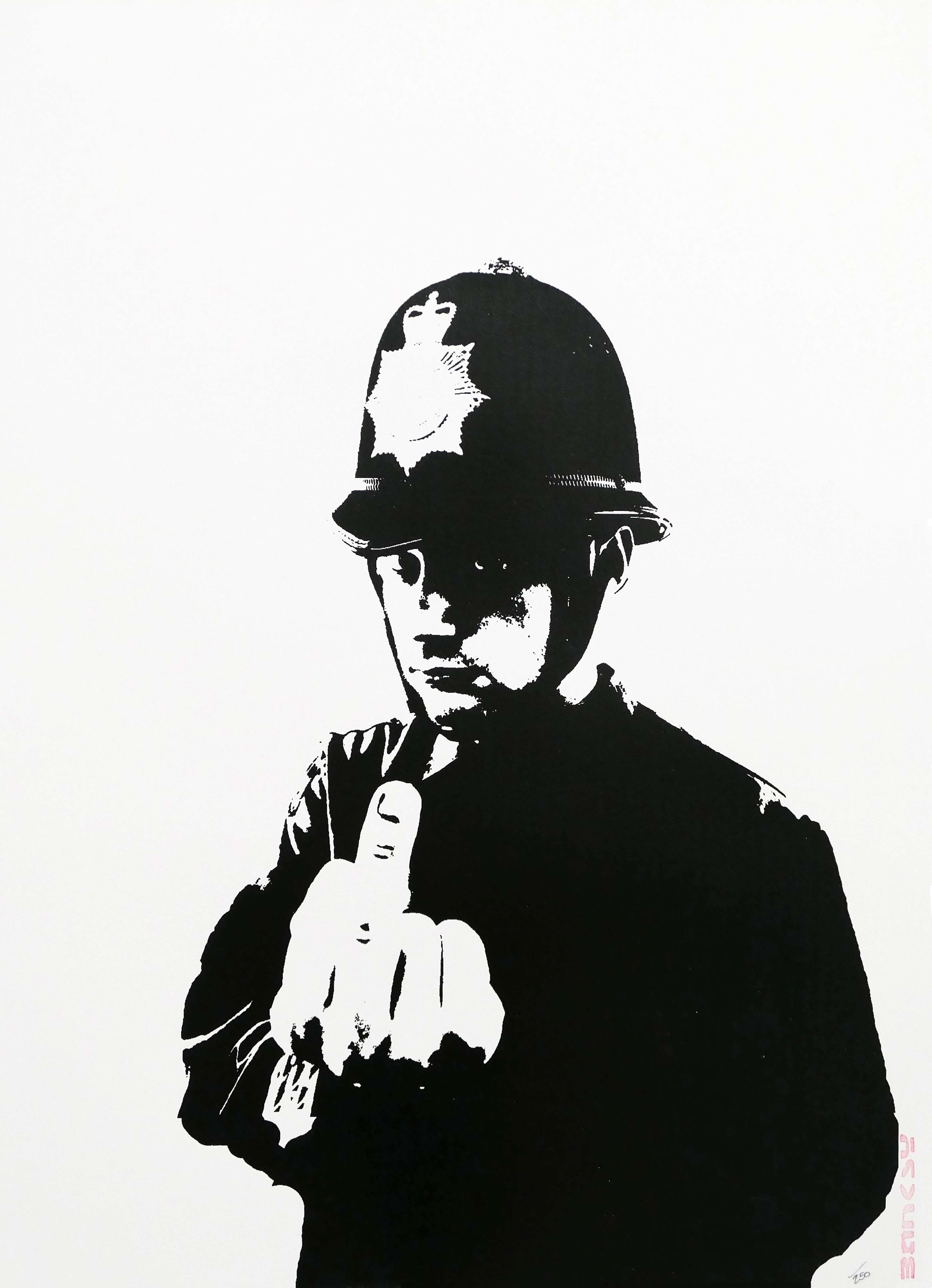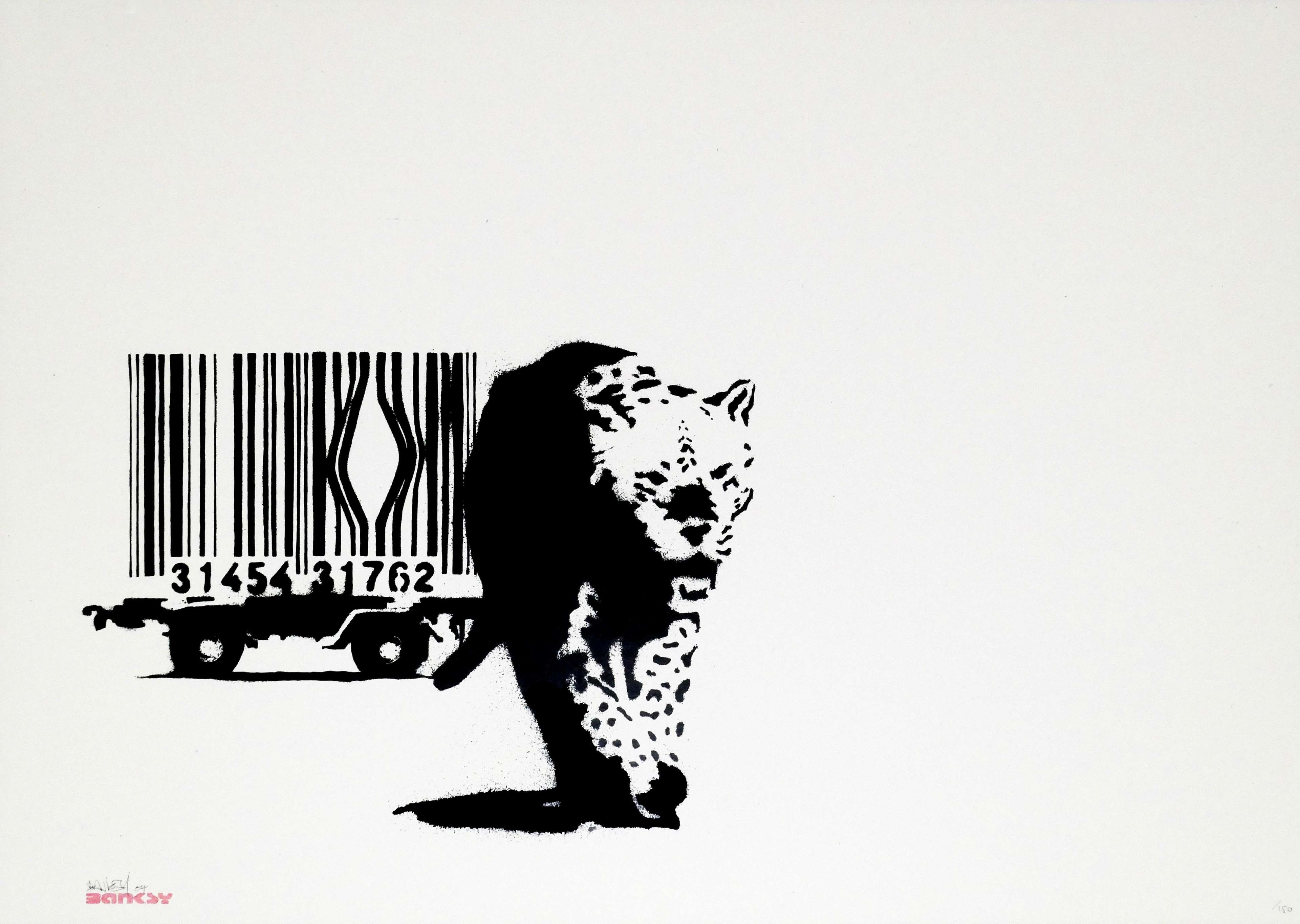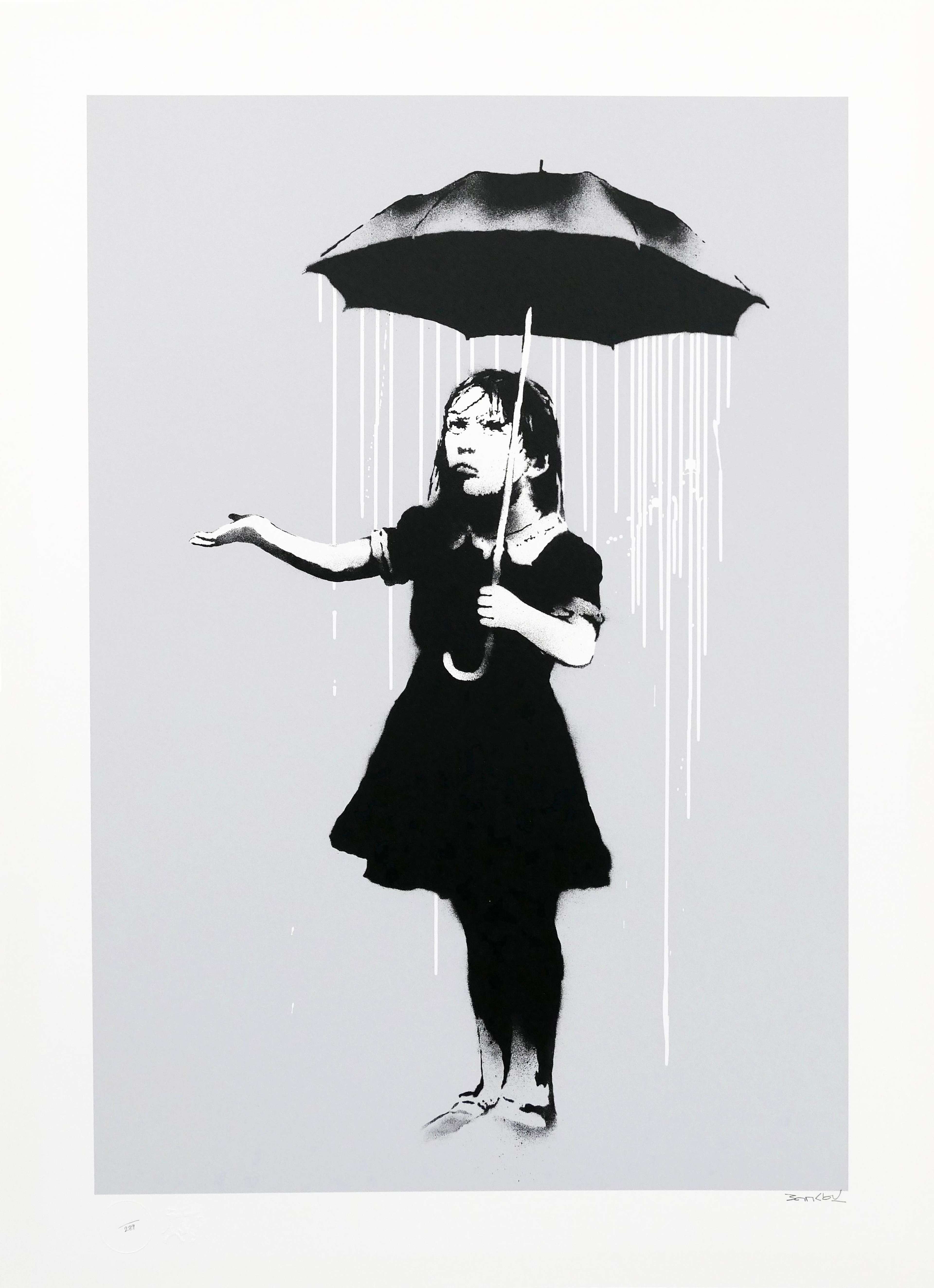 Choose Your Weapon (bright purple) © Banksy 2010
Choose Your Weapon (bright purple) © Banksy 2010
Banksy
269 works
Soup cans, celebrities and cultural events – Banksy continues Andy Warhol's legacy of exploring trends and issues in contemporary society. Here are some of the graffiti artist’s prints with a true Pop Art spirit.
Pop Art is a revolt against the old. The most famous Pop Artists of the 1950s and ’60s – Roy Lichtenstein, Keith Haring and, of course, Andy Warhol – wanted their art to break away from the past and reflect the zeitgeist. Although Pop Art reached its peak popularity in the 1960s, its spirit is still alive and kicking today.
Many of Banksy’s artworks pay homage to Warhol and Haring, while other works address the zeitgeist of the 2000s. Here are some of his top prints that continue the Pop Art spirit.
Banksy and soup cans
What does Banksy’s soup can mean?
Banksy’s Tesco Value Tomato Soup Can print is, on the one hand, a playful homage to Warhol’s famous Campbell soup cans. On the other hand, it is a cutting remark on the rising poverty in Britain, with more people surviving on a tight budget where only low-value, supermarket brand items are affordable. Unlike Warhol, who has featured 32 flavours of Campbell soups, Banksy offers only one: cream of tomato.
Has Banksy made other prints about Tesco?
In addition to Soup Can, Banksy has made a print titled Very Little Helps (also known as Tesco Flag or Tesco Kids), a reference to Tesco’s slogan “Every little helps”. The artwork shows three children pledging their allegiance to a flag made from a Tesco plastic bag. It is seen as a criticism of the supermarket’s monopoly on the British high street, pushing small independent shops out of business.
Banksy and celebrity culture
Which Banksy artworks feature celebrities?
Banksy’s celebrity icons include supermodel Kate Moss and Sex Pistols bassist Sid Vicious. Both works are a clear tribute to Warhol’s Pop Art portraits, particularly the Marilyn Monroe and Elvis works. Banksy’s Kate Moss even superimposes Monroe’s hair onto Moss’s face and, like Marilyn, the prints are available in different colourways. When the Kate Moss prints were made, in 2005, the supermodel was making headlines for her drug use and relationships – again, much like Monroe.
Which Banksy prints feature cultural icons?
Banksy’s fictional icons include Winnie the Pooh, Dumbo, Dorothy and Toto from Wizard of Oz, Disney’s The Jungle Book and Pulp Fiction’s Jules and Vincent – all depicted with a mischievous Banksy twist, of course.
In the first four artworks, the family-friendly characters all suffer a dark turn. Pooh, reaching for a honey pot marked with a $ sign, walks into a bear trap. Dumbo is attacked by Syrian rebels. Dorothy is stopped and searched by a police officer in riot gear. In Save or Delete Jungle Book, made for a Greenpeace campaign in 2001, Mowgli and his friends await execution against a deforested jungle. Ironically, Banksy turns the violence in Pulp Fiction on its head by giving the two hitmen characters comical bananas instead of guns. In each print, Banksy shines a light on the commonness of violence in everyday life – whether it is in the global news, in our growing surveillance society, or in our movies and entertainment.
Banksy’s landmark events
Which Banksy prints reflect contemporary events?
Just as Warhol captured contemporary landmark events like the 1969 moon landing, Banksy’s Nola is a metaphorical take on the real destruction Hurricane Katrina inflicted on New Orleans in 2005. The artwork, which shows rain pouring onto the young girl from inside the umbrella, criticises the New Orleans government for failing to do enough to help civilians, even implying their complicity in the damage caused.
Which Banksy prints show historical events?
Banksy’s Napalm and Flags are two prints which reference historic events to address current issues. Released in 2003, the shocking Napalm reinvents the famous 1972 Vietnam War photo The Terror Of War to show young war victim Phan Thi Kim Phuc being led by Mickey Mouse and Ronald McDonald. Banksy uses these vacant, smiling cartoon characters to denounce the multinational brands growing rapidly in the 1990s and 2000s for their lack of humanity and their damaging influence, particularly on children.
Flags, like Napalm, references another famous image, this time the 1945 photograph Raising The Flag On Iwo Jima. But while the original photo celebrates American victory and patriotism, Banksy’s reimagining is more open to interpretation. It can be seen as children fighting in a world ruined by adults or chasing the American dream in a dystopian setting – all very relevant in a time of ecological destruction and financial insecurity for the younger generations.
Banksy and society
How do Banksy’s prints reflect societal issues?
Banksy’s 2010 print Choose Your Weapon addresses the rise of violence and gang culture on the streets of the UK. According to the artist’s own interpretation, aggressive dogs have become an alternative weapon to knife crime. The barking dog is a homage to Keith Haring’s iconic dog motif and also suggests that, for Banksy, his weapon of choice is street art.
Banksy often employs animals to deliver cutting commentary on current societal issues. His recent series of animal murals in London this summer can be interpreted as addressing themes of isolation, oppression, and environmental distress. From the mountain goat teetering on the edge of Kew Bridge under surveillance, to the lone wolf silhouetted on a satellite dish in Peckham, Banksy’s choice of animals serves as a metaphor for societal vulnerability and survival under watchful control. The goat, possibly a symbol of humanity on the brink, or an endangered Palestinian gazelle, mirrors the precarious state of society or nature under constant threat. The elephant duo in Chelsea may allude to the 'elephants in the room', referring to ignored yet pressing social issues, while the monkeys in Brick Lane seem to reference moral indifference through the 'see no evil' proverb. Each work cleverly incorporates its urban surroundings, transforming ordinary locations into statements on political inaction, environmental collapse, and societal breakdown. Banksy’s refusal to provide commentary emphasises the open-ended nature of his art, encouraging public dialogue about these critical issues
Consumer society is another favourite theme in Banksy’s art. While Warhol openly embraced consumerism and spending (going as far as to make a print of a dollar sign so collectors could literally hang money on the wall), Banksy is more critical. In addition to Napalm, Banksy’s prints Christ With Shopping Bag and Sale Ends, made in the early 2000s, all suggest that shopping has become the new religion in contemporary society.














